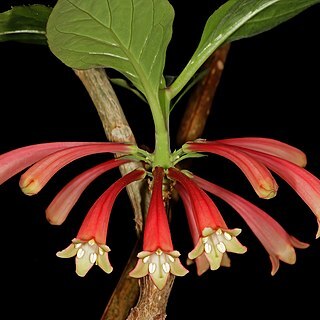A glabrous epiphytic shrub; rootstock 4 ft. high, about 1/3 in. thick but increasing towards the top to 2 in. thick, furrowed transversely as in a Dahlia root; rootlets fibrous; stems more or less quadrangular; ultimate branchlets 1/8-1/6 in. thick; leaves opposite, decussate, ovate or elliptical, acute or broadly pointed at the apex, more or less narrowed at the entire base, strongly toothed or repand-dentate, fleshy, red-veined, turning black-green in the dried state, 2-6 in. long, 1-3 3/4 in. broad; petioles 2/5-2 in. long; flowers clustered at the nodes on the branchlets, usually three together, bracteate at the base, 1 1/2-1 3/5 in. long; peduncles 1/12-1/6 in. long, spreading; bract elliptic-linear, acute at both ends, about 3/4 in. long, 1/6 in. broad; calyx-segments lanceolate, acute, glabrous, 1/8-1/6 in. long; corolla red ?; tube beset inside towards the base with stiff broad white hairs; lobes about 1/6 in. long; anthers 3/32 in. long, glabrous; style glabrous, slender, tapering towards the stigma; ovary ovoid-conical, glabrous; ripe berry ovoid, blunt, smooth, 3/4-4/5 in. long, 2/3-5/12 in. broad, 1/2-3/5 in. thick, green; embryo about 1/3-3/4 of the seed in length.
More
Perennial, softly woody, glabrous, usually epiphytic, small shrub; stems up to 1 m long, branched. Leaves opposite and decussate, ovate or elliptical, petiolate, ± toothed and fleshy with red veins. Flowers mostly in threes, at nodes of branchlets with short pedicels. Calyx shortly tubular with 5 lanceolate lobes. Corolla red or pinkish red with long, subcylindrical tube becoming funnel-shaped above, and 5 short, flaring, ± ovate lobes. Flowering time June-Aug. (early spring), just before leaves appear.

